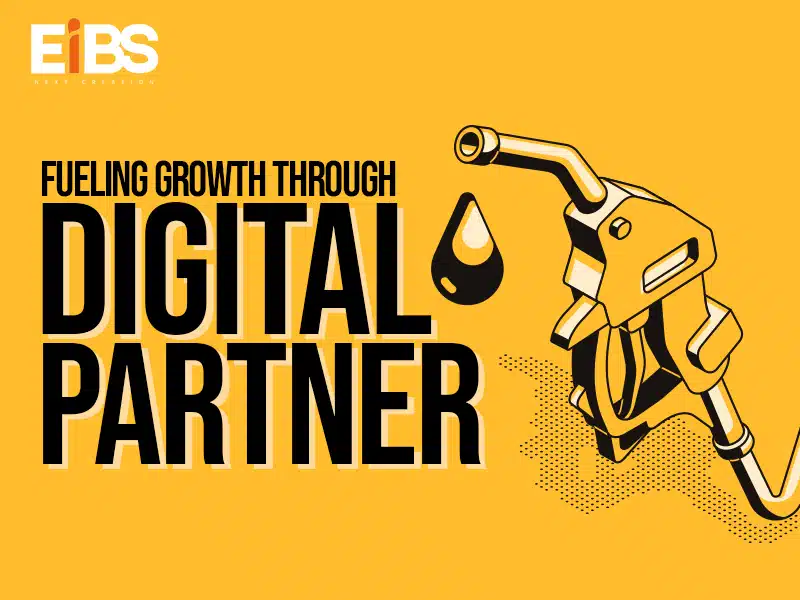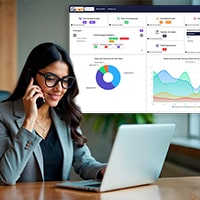
Fueling Growth Through Digital Transformation – EIBS The Best Digital Partner
What is digital transformation?
Digital transformation benefits both sell-side customer engagements and buy-side supplier relationships.
Digital transformation is the process of using digital technologies to create new — or modify existing — business processes, culture, and customer experiences to meet changing business and market requirements. Thus, digital transformation is the process of rethinking business in the digital age.
Sales, marketing, and customer service are just a few examples of traditional roles. Digital transformation, on the other hand, starts and ends with how you think about and interact with customers.”
Scope of Digital Transformation
According to David of EIBS, in his book Digital Marketing: Strategy, Planning, and Implementation, the scope of transformation should include managing and leveraging these “5Ds of Digital.”
The 5Ds explain the various methods in which consumers can interact with brands and businesses can reach out to and learn from their target audiences:
• Digital Devices
• Digital Platforms
• Digital Media
• Digital Data
• Digital Technology
Digital Devices
Audiences interact with businesses using various linked devices like smartphones, tablets, desktop computers, TVs, and gaming devices as they interact with corporate websites and mobile apps.
Digital Platforms
The majority of interactions on these devices take place in a browser or through apps from the major platforms or services, which include Facebook (and Instagram), Google (and YouTube), Twitter, and LinkedIn.
Digital Media
Advertising, email and message, search engines, and social networks are examples of paid, owned, and earned communication channels for reaching and engaging audiences
Digital Data
In most countries, the information businesses acquire about their audience profiles and interactions with businesses must now be secured by law.
Digital Technology
Businesses use marketing technology to create interactive experiences ranging from websites and mobile apps to in-store kiosks and email campaigns.
Digital Transformation’s Advantages
Evolving Customer Experience
Digital businesses must prioritize the customer experience. Customers are constantly searching for useful and simple solutions to their problems, and they expect them quickly. Organizations are becoming more conscious of this and are devoting more time and resources to developing layered digital transformation strategies to improve their customers’ experiences.
Data-based Insight
Metrics can be tracked easily and accurately with the help of digital technology, which also promotes transparency. These insights enable firms to improve their processes and get better results. Such data-driven insights aid in better understanding customers, improve corporate strategies, assist in enhanced decision-making, and provide the groundwork for a higher return on investment.
Collaboration like Never Before
Organizations can identify inefficiencies in processes thanks to digital transformation. It also allows for open communication amongst the many parties. It provides a fantastic chance for executives to set organizational goals and create roadmaps for individuals and teams to achieve digital consistency.
Profitability, Agility, and Innovation
When an organization’s activities are digitalized, it results in better savings and sales. Digital transformation is inextricably connected to the reduction of manual interventions, resulting in speedier and error-free processes. This encourages flexibility and creativity in satisfying client needs.
How you Approach Digital Transformation
Digital transformation is based on business design concepts, lean startup thinking, customer centricity, agile best practices, and traditional change management methodologies. We used this strategy to build Food, the Netherlands’ first open food marketplace. Your digital transformation efforts will have the highest chance of success if you take a holistic approach. Here’s a short checklist to get you excited:
1) Understand and visualise everyday basics with the help of the business model and business case.
2) Understand the organisational, process, and technical capabilities that are currently in place.
3) Understand whether the “where to play” and “how to win” are already obvious or whether Service Design/Business Design is required.
4) Rapid Prototyping: Using lean-startup thinking, define “Digital Needs,” discover “Use Case Opportunities,” and begin “Rapid Prototyping.”
5) Define important hypotheses and elaborate or refine them in your digital strategy/business case.
6) Definition of the target operating model includes a gap analysis of key enablers or competencies and selecting a “winning team” capable of driving change and acting as ambassadors.
7) Establish a small enough agile organisation with C-Suite backing, educate agile principles, and teach senior management to build-measure-learn thinking.
8) Set up technological and procedural barriers, such as continuous delivery, accelerator components, and training.
9) Rapidly identify, build, test, and adjust a Minimal Marketable Product, which includes developing a customer experience, target architecture, and technology choices.
 
conclusion
Make sure you have a solid partner that has a comprehensive understanding of your business. EiBS – The Best Digital partner to make your business level high. Get in touch with us to learn make your company growth to the sky. Know more about digital transformation


